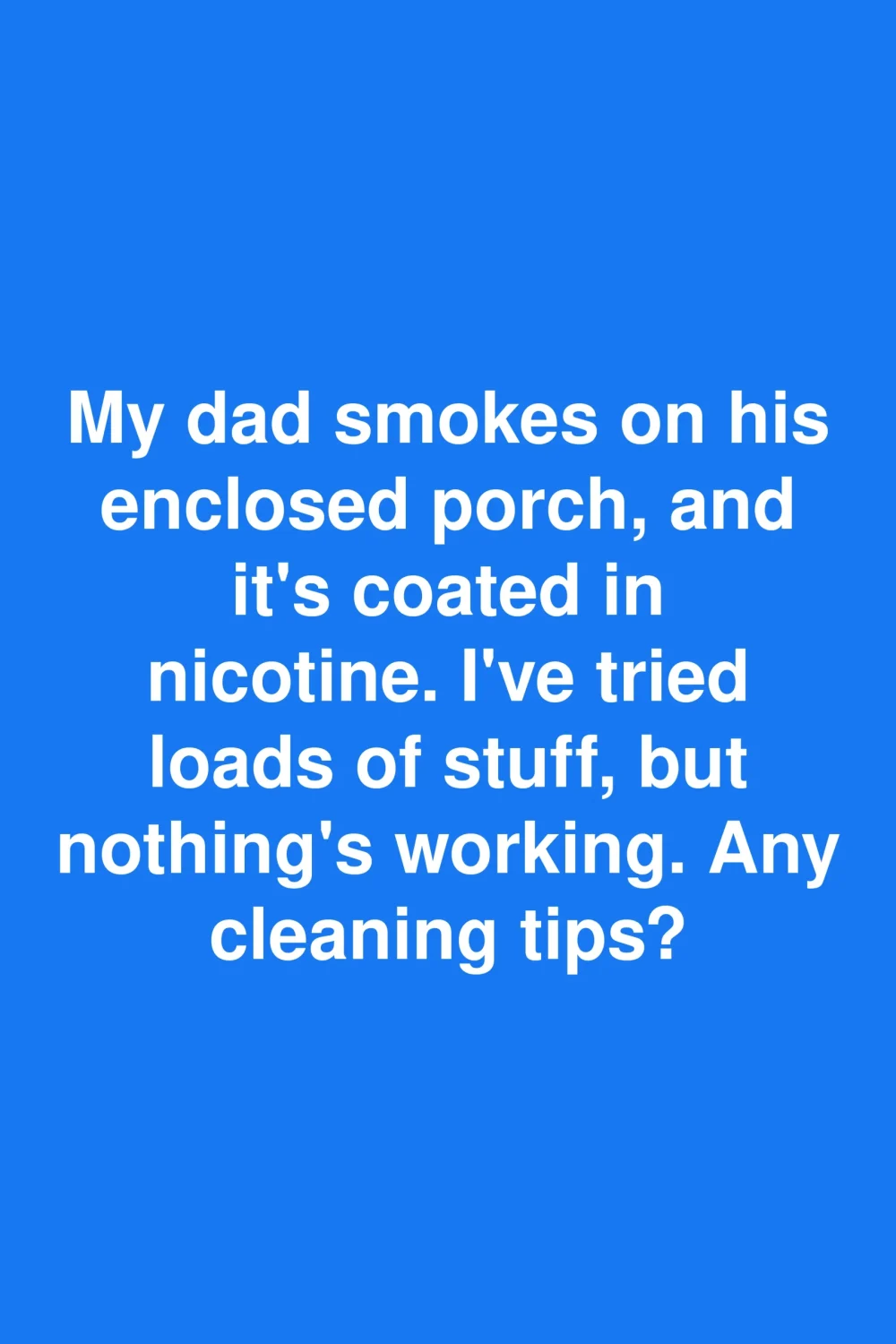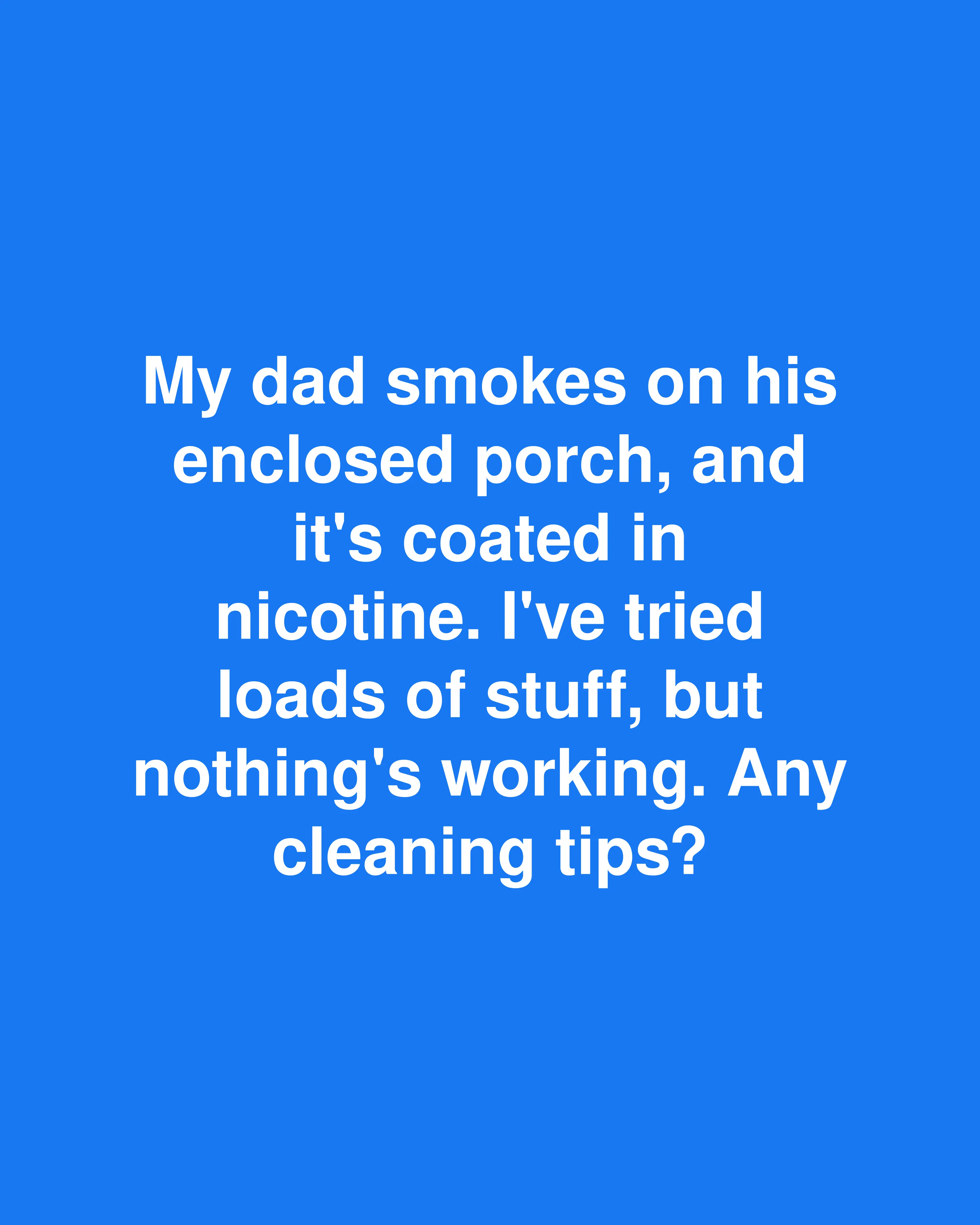Want to save this recipe?
Enter your email below and we’ll send the recipe straight to your inbox!
Banishing Nicotine Residue: The Ultimate Guide to Cleaning Your Enclosed Porch
Have you ever walked into an enclosed porch and immediately noticed that unmistakable yellowish tint on the walls and the lingering smell of cigarettes? Nicotine residue is notoriously stubborn, clinging to surfaces with remarkable tenacity. Whether you’ve inherited a smoker’s porch or are trying to clean up after years of indoor smoking, this guide will help you transform that sticky, discolored space back into a fresh and inviting area.
Understanding the Nicotine Challenge
Nicotine isn’t just any ordinary stain. When cigarette smoke wafts through an enclosed space, it deposits a sticky, tar-like substance on every available surface. This residue contains thousands of chemicals that bond to walls, ceilings, furniture, and even window glass. In poorly ventilated areas like enclosed porches, this buildup becomes particularly concentrated.
The yellowish-brown film doesn’t just look unappealing—it continues to release odors and potentially harmful compounds long after the last cigarette has been smoked. This is why simply masking the smell with air fresheners never truly solves the problem.
The Most Effective Cleaning Solution
After testing numerous methods, trisodium phosphate (TSP) consistently proves to be the most effective cleaner for nicotine residue. This heavy-duty cleaner breaks down the sticky bonds of nicotine in ways that regular household cleaners simply cannot match.
Before rushing to purchase TSP, it’s worth noting that it’s a strong chemical that requires proper handling. Always wear rubber gloves, eye protection, and ensure good ventilation when using it. For those concerned about environmental impact, there are TSP substitutes available that offer similar cleaning power with less environmental concern.
Step 1: Clear and Prepare the Space
Begin by removing all furniture, curtains, rugs, and decorative items from the porch. This not only gives you unobstructed access to all surfaces but prevents cleaning solutions from damaging your belongings.
Open all windows and doors if possible, and set up fans to improve ventilation. The cleaning process will temporarily worsen odors as you disturb the nicotine residue, so good airflow is essential.
Step 2: Dry Cleaning First
Before introducing any liquid cleaners, remove loose debris with a vacuum equipped with a HEPA filter. Use the brush attachment to go over walls, ceilings, and any built-in fixtures. This preliminary step prevents spreading dust and debris when you start wet cleaning.
For textured surfaces like popcorn ceilings or rough-textured walls, try using a dry cleaning sponge (also called a chemical sponge) first. These specialized sponges lift away surface grime without water and can significantly reduce the amount of residue before wet cleaning begins.
Step 3: The TSP Treatment
Mix 1/4 cup of TSP with one gallon of warm water in a bucket. For particularly heavy buildup, you might need a slightly stronger solution. Dip a sponge into the solution, wring it until it’s not dripping, and begin washing the surfaces.
Work in small sections of about 3×3 feet, starting from the ceiling and working your way down. This prevents cleaned areas from being streaked by dirty runoff. For ceilings and high walls, a mop with a microfiber head attached to an extension pole works wonders.
After applying the TSP solution, rinse each section with clean water to prevent chemical residue. Change your rinse water frequently to avoid redepositing nicotine onto cleaned surfaces.
Step 4: Addressing Stubborn Areas
Some areas, particularly corners and areas directly above where smoking occurred, may require additional attention. For these stubborn spots:
- Create a paste of baking soda and water
- Apply it to the stained area and let sit for 15-20 minutes
- Scrub gently with a soft brush
- Rinse thoroughly
For extremely persistent stains, a magic eraser (melamine foam) can be effective but use it sparingly on painted surfaces as it can remove paint.
Common Mistakes to Avoid
Using Vinegar as Your Primary Cleaner
While vinegar is touted as an all-purpose natural cleaner, it’s surprisingly ineffective against nicotine. The acidic properties don’t break down the alkaline residue well, and you may end up with a porch that smells like both cigarettes and vinegar!
Painting Over Without Proper Cleaning
Many people attempt to shortcut the process by simply painting over nicotine stains. Unfortunately, nicotine bleeds through regular paint, often reappearing within weeks. If you plan to paint after cleaning, use a stain-blocking primer specifically designed to seal in residue.
Neglecting Soft Surfaces
While walls and ceilings are obvious targets, nicotine clings to everything—including fabric window treatments, cushions, and rugs. These soft items often harbor the most lingering odors. Either clean them thoroughly using appropriate methods or consider replacing them entirely.
Extra Benefits of a Thorough Nicotine Cleaning
Health Improvements
Removing nicotine residue doesn’t just improve appearances—it eliminates “thirdhand smoke,” which continues to release harmful compounds into the air. Studies show that these compounds can be particularly dangerous for children and pets who have more contact with surfaces.
Property Value Protection
A clean, odor-free porch increases your property’s value and appeal. Real estate professionals report that cigarette odors are among the most common dealbreakers for potential buyers or renters.
Extended Durability
Nicotine residue is acidic and can gradually deteriorate paint, varnish, and even structural elements. By removing it completely, you’re protecting your porch from premature aging and costly repairs.
Preventative Measures for Smokers’ Spaces
If smoking will continue on the porch, consider these preventative steps:
- Install an exhaust fan or air purifier with a HEPA filter
- Apply washable paint that resists staining
- Place washable slipcovers on furniture
- Schedule regular cleaning sessions before buildup becomes severe
- Place activated charcoal odor absorbers around the space
Quick Recap & Practical Conclusion
Tackling nicotine residue requires more than standard cleaning approaches. Start with proper preparation and dry cleaning, then progress to TSP solution for the heavy lifting. Address stubborn areas with specialized techniques, and don’t forget to clean or replace soft furnishings.
The transformation won’t happen instantly—severe cases might require multiple cleaning sessions—but the results are worth the effort. A clean, fresh-smelling porch becomes an inviting extension of your home rather than a space you’d prefer to avoid.
Your enclosed porch can become your favorite spot for morning coffee, evening relaxation, or entertaining friends—without any lingering reminders of its smoky past.
Frequently Asked Questions
How long does the cleaning process typically take?
For an average-sized enclosed porch with moderate nicotine buildup, expect to spend 4-6 hours on the initial deep clean. Severe cases might require multiple sessions over several days.
Do I need to replace the flooring too?
It depends on the flooring type. Hard surfaces like tile, vinyl, or sealed wood can usually be thoroughly cleaned. However, carpeting often retains nicotine odors and may need replacement for complete odor elimination.
Will air purifiers help with the cleaning process?
While air purifiers with HEPA filters can help reduce airborne particles during and after cleaning, they cannot remove the residue from surfaces. They’re best used as a supplementary approach, not a replacement for thorough cleaning.
How can I tell if my cleaning efforts were successful?
Beyond the visible improvement, the most reliable test is to leave the space closed up for 24-48 hours, then enter with a “fresh nose.” If you can still detect cigarette odors, some residue likely remains and additional cleaning is needed.


